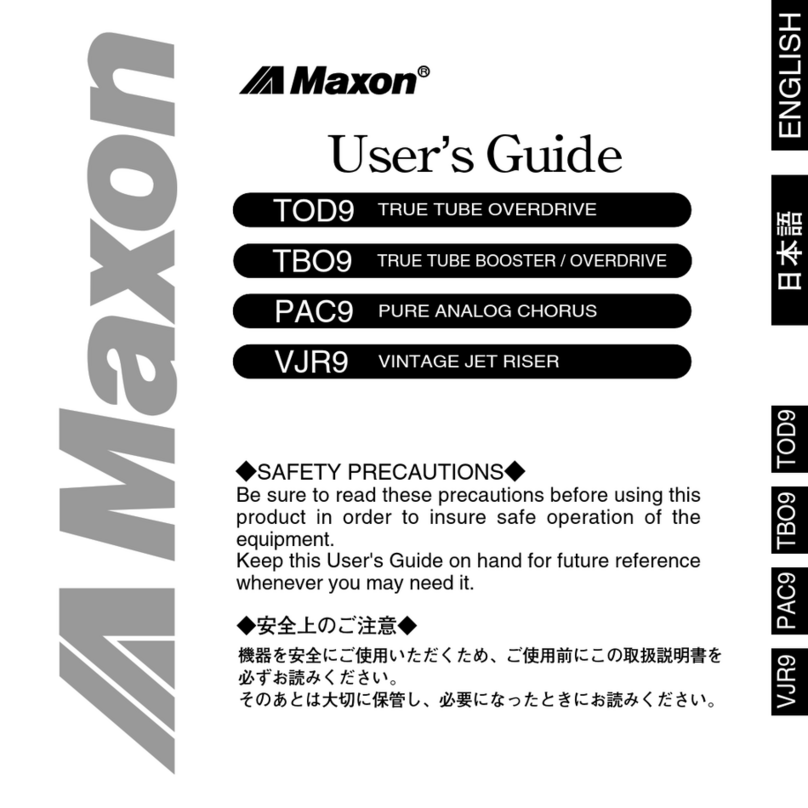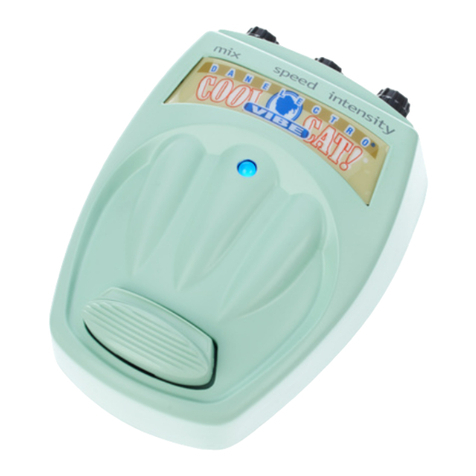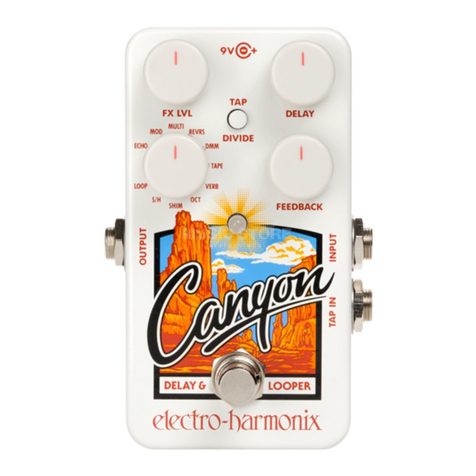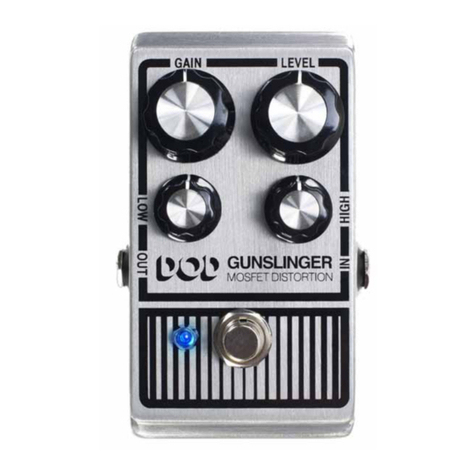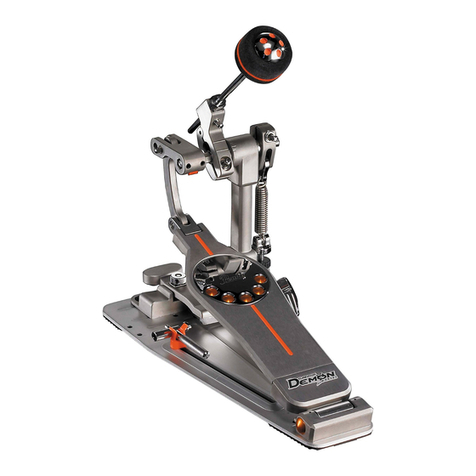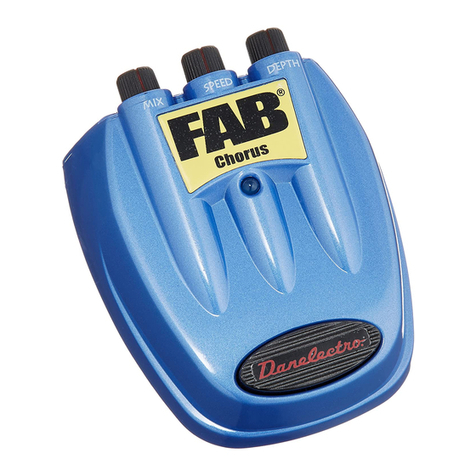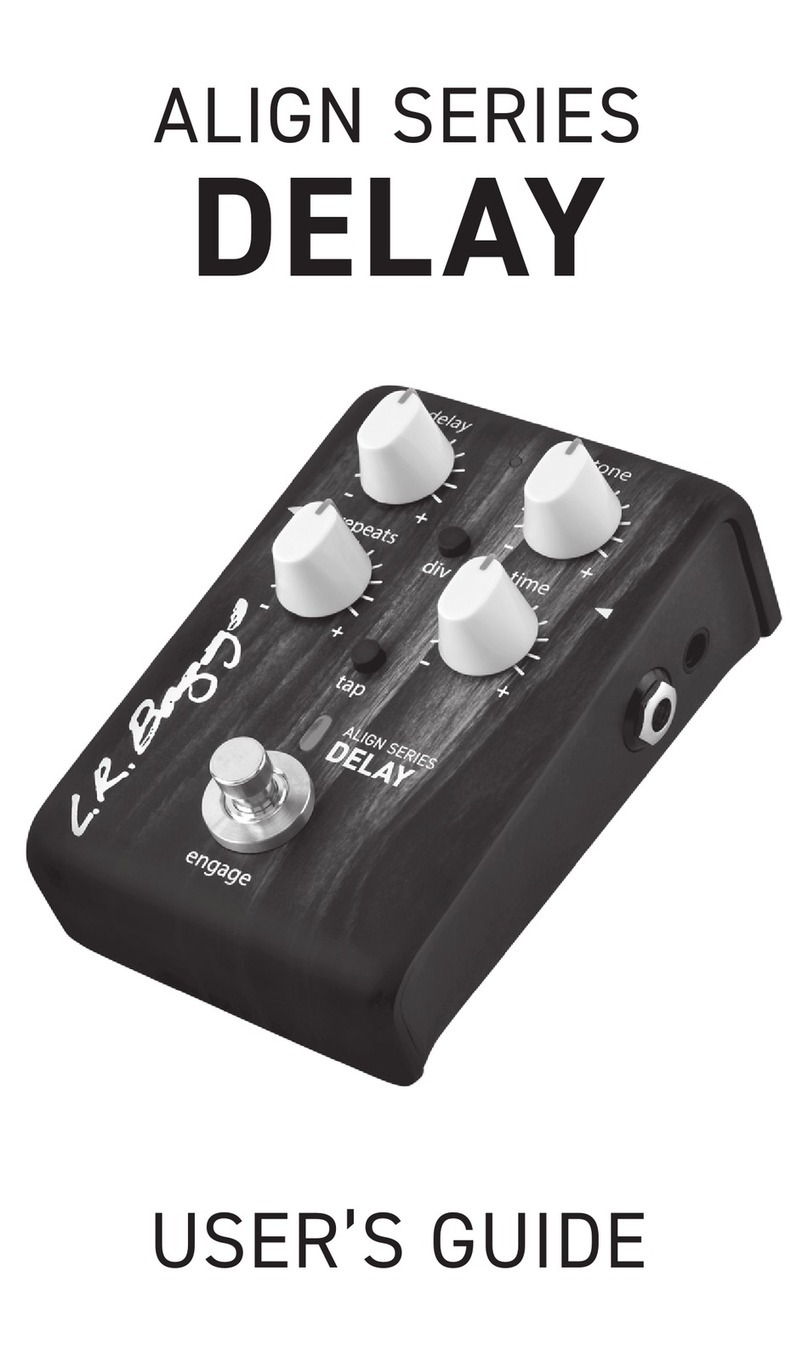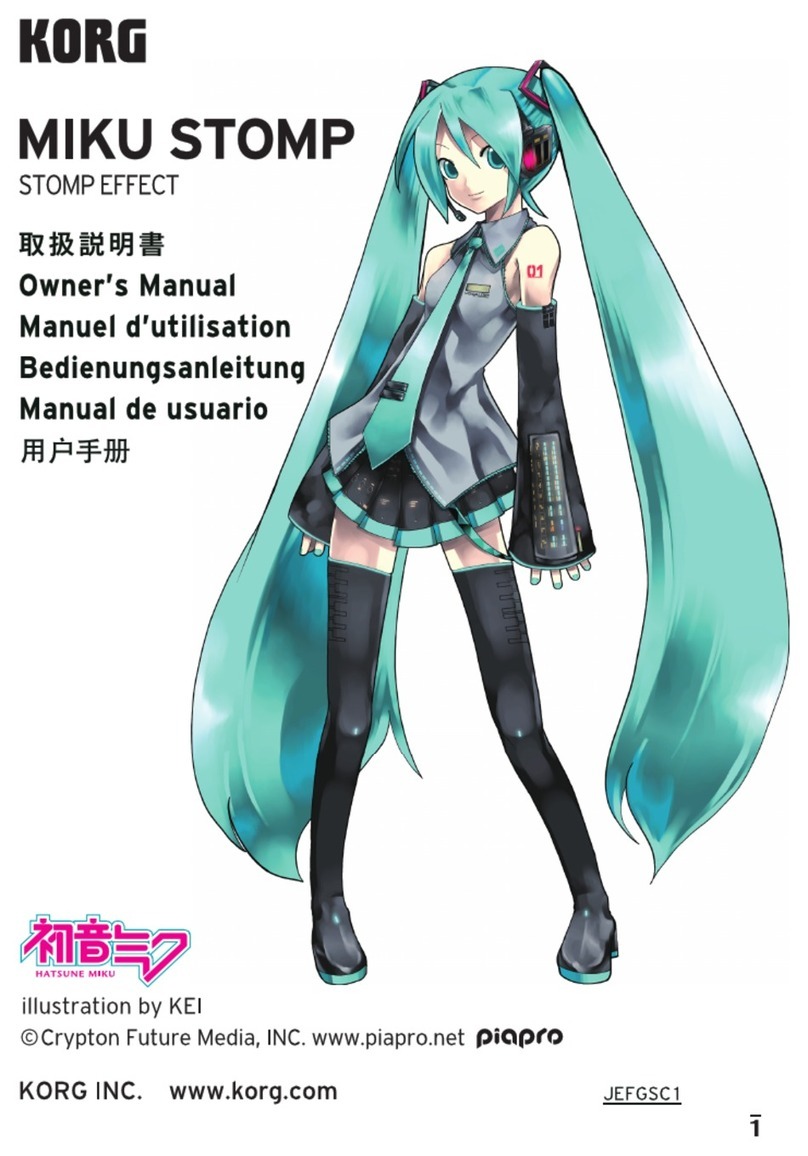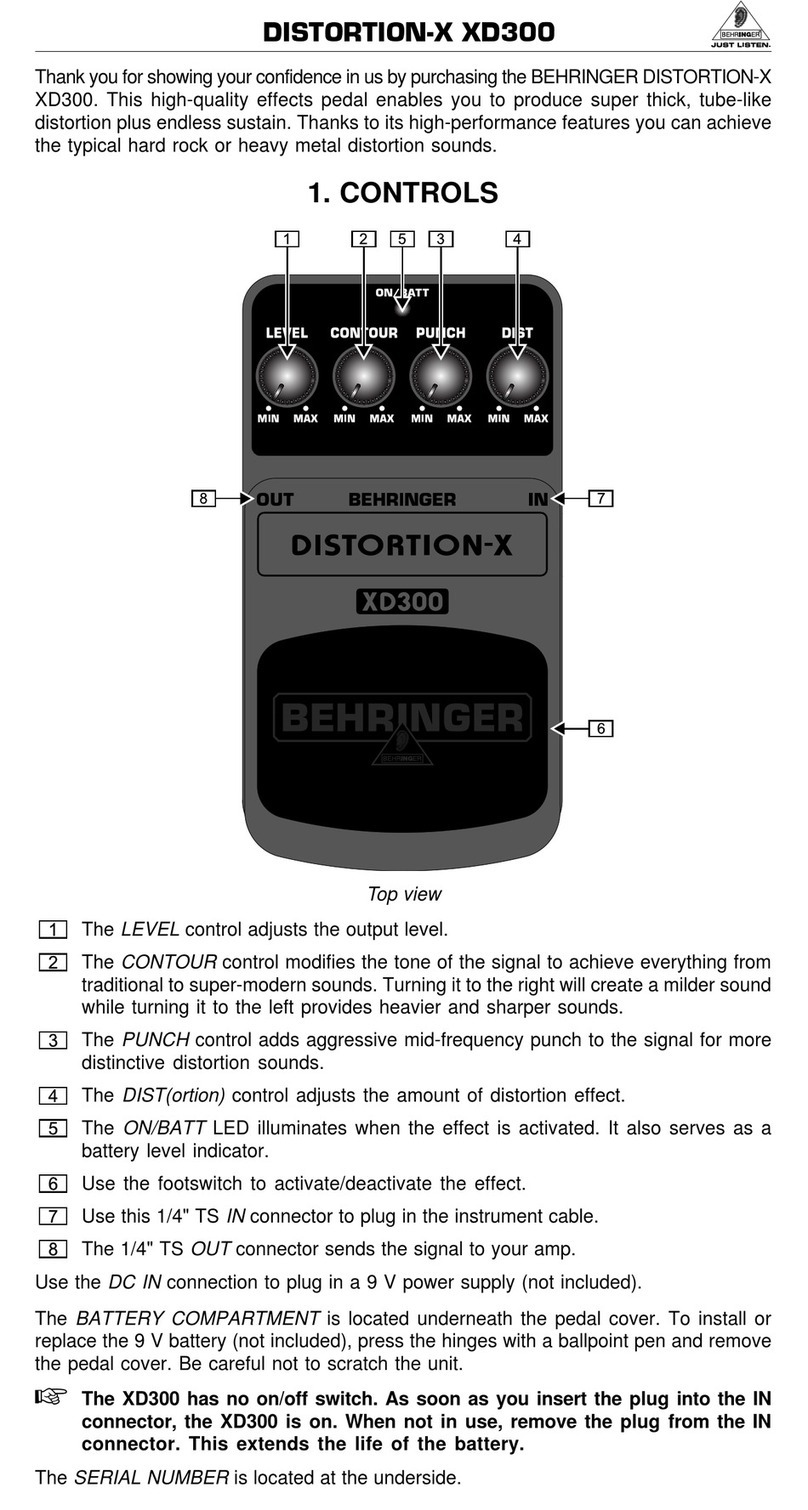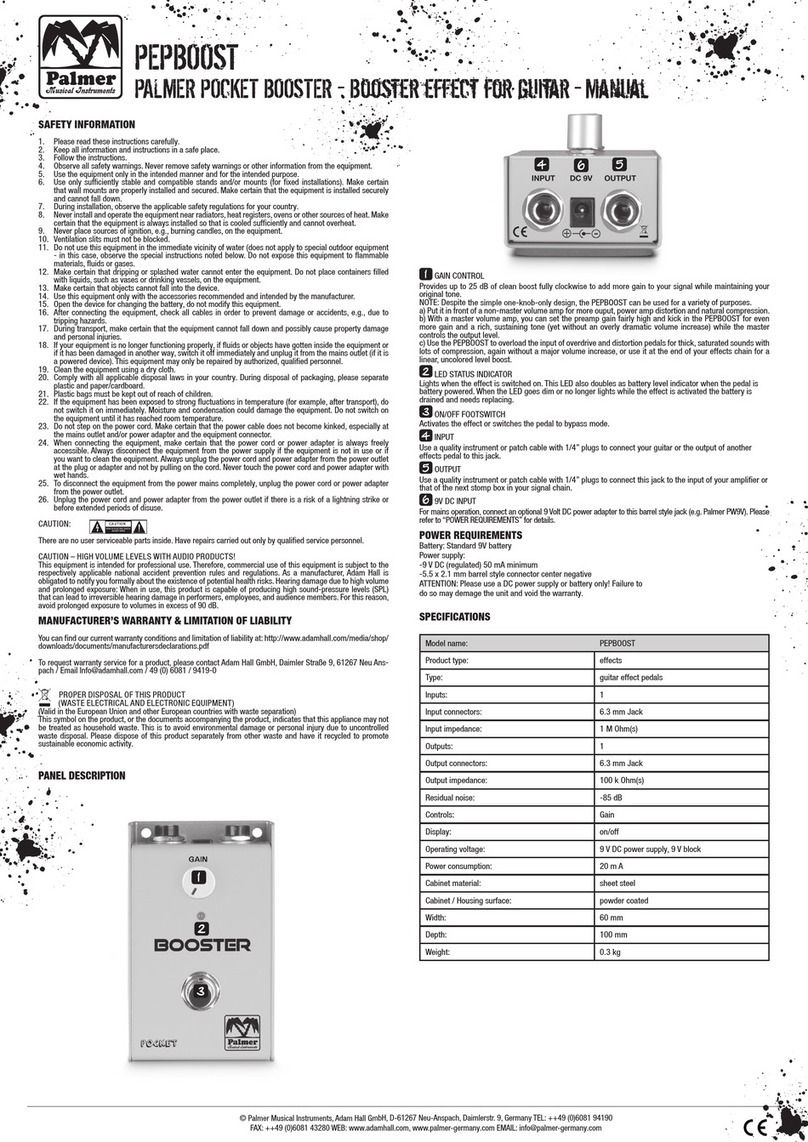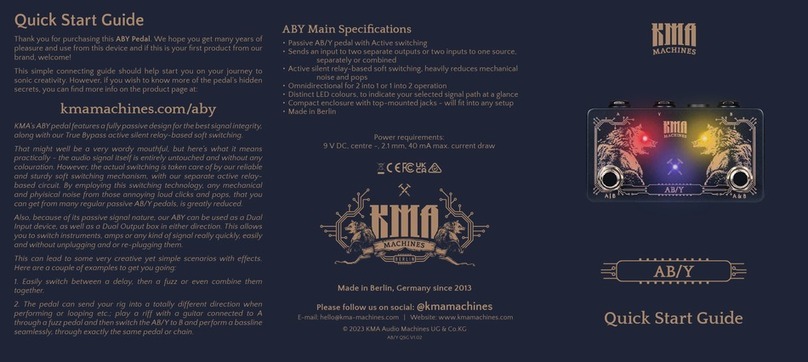Studio Electronics MODMAX User manual

Prima res
: Connect the supplied 9 Volt DC adapter to the female DC power jack on the
rear panel, as the MODMAX operates on a universal switching power supply - NO BATTERIES!
1. INPUT control (has corresponding jack on back panel): Wide-range input level control
for guitar, instrument, or program material; INPUT shorts to OUTPUT when bypassed.
2. OUTPUT control (also has corresponding jack on back panel): Output level control for
gain matching of effected and non-effected signal.
3. DRENCH OFF/ON:
Effect output level overload - Can produce a SERIOUS GAIN INCREASE... proceed
with caution! Use the mix control for reducing the gain; the drench overloads the output
of the effect signal, so by reducing the amount of effect level, you will lower the overall
gain.
a MIX: Balance control for DRY and WET signal. Center position = 50/50 blend.
b DYNAMICS (center detent pot): Dynamic level control of MIX: when the MIX control is
set to the "=" position, the dynamic sweep of full positive modulation will be from "=" to
100% wet; with the same MIX setting, the dynamic sweep of full negative modulation will
be from "=" to 100% dry.
4. FILTER MODE: Low Pass; Band Pass; High Pass. The different modes of the filter will
determine which audio frequencies are "passed through". Low Pass allows the fullest audio
spectrum to pass, while Band Pass, and High Pass allow only selected frequencies to enter
through the filter.
a FREQUENCY: Sets the initial frequency of the filter.
b RESONANCE: Adds "Q" or definition to the selected frequency of the filter.
5. NORM; TRIG; ONE SHOT: These are the triggering modes of the LFO. When set to NORM,
the LFO is free running; in TRIG mode, the start of the LFO cycle re-triggers with dynamic
level - the trigger point being the lighting of the red LED; in ONE SHOT, a single cycle of
the LFO is triggered (making the LFO act like an envelope for interesting sweep effects). The
combination of the INPUT level and the ATTACK and RELEASE controls determines when
the dynamic level is high enough to illuminate the red LED. Re. waveform cycles: The start
of the triangle waveform's cycle is at the bottom of the waveform, the start of the square's
at the top of the waveform, and the S/H's is random.
(envelope detector circuit)
a ATTACK: How fast the envelope will respond to each new strike, e.g., audio info..
b Trigger level L.E.D.s.
(continued on back page)

c RELEASE: How fast each newly sent level will decay. A sufficient amount of release time
is required for the envelope itself to trigger: more input less release - less input more release
(general rule of thumb). The balance of these two critical controls create the response of
the envelope detector circuit; depending upon your inout material adjust to taste. Note:
Longer attack times will be smoother, but slow the re-triggering of the envelope.
6. FREQ DYNAMICS: This control sets the dynamic range of the filter sweep. Varying the
FREQUENCY setting and the FREQ DYNAMICS setting will determine the width of the sweep
and the initial frequency of the sweep.
6a Negative-Positive Switch: This sets the polarity of the filter sweep.
7. RATE DYNAMICS (center detent pot): Dynamic control of the LFO rate. Positive modulation
increases the LFO rate, while negative modulation decreases the LFO rate. The LFO rate
pot will determine the initial or starting LFO rate: use this control to speed up or slow
down the LFO with varying dynamic levels.
8. DEPTH DYNAMICS (center detonate pot): Dynamic control of the LFO depth. Positive
modulation increases the LFO depth, and yes, negative modulation decreases the LFO depth.
The LFO depth pot will determine the initial or starting LFO depth: use this control to
increase or decrease the LFO depth with varying dynamic levels.
8a LFO SLOW-FAST Switch: "...from a tortuously slow crawl to scorchin' lightning-quick,
audio-frequency modulation." Exact times/speeds available at our website after this prints.
9. LFO WAVEFORM: Triangle; Square; Sample & Hold
a RATE: Initial LFO rate before dynamic level is applied.
b LFO rate L.E.D..
c DEPTH: Initial LFO depth before dynamic level is applied.
For additional assistance and occasional free stuff, continue to allow your eyes to drift downward.
Happy stompboxing!
The ANALOGIA INC. Crew 7-8-2003.
QUICK START GUIDE

Prima res
: Connect the supplied 9 Volt DC adapter to the female DC power jack on the
rear panel, as the MODMAX operates on a universal switching power supply - NO BATTERIES!
1. INPUT control (has corresponding jack on back panel): Wide-range input level control
for guitar, instrument, or program material; INPUT shorts to OUTPUT when bypassed.
2. OUTPUT control (also has corresponding jack on back panel): Output level control for
gain matching of effected and non-effected signal.
3. DRENCH OFF/ON:
Effect output level overload - Can produce a SERIOUS GAIN INCREASE... proceed
with caution! Use the mix control for reducing the gain; the drench overloads the output
of the effect signal, so by reducing the amount of effect level, you will lower the overall
gain.
a MIX: Balance control for DRY and WET signal. Center position = 50/50 blend.
b DYNAMICS (center detent pot): Dynamic level control of MIX: when the MIX control is
set to the "=" position, the dynamic sweep of full positive modulation will be from "=" to
100% wet; with the same MIX setting, the dynamic sweep of full negative modulation will
be from "=" to 100% dry.
4. STAGES: Defines the amount of the phase circuits employed. Try "2" for a tremelo effect,
"4" for a classic deep phased effect, and "6" for a da@# near flanged effect. With MIX
set to 100% wet, subtle shallow vibrato to aggressive pitch shifting can "echo softly... through
the canyons of your mind."
a FREQUENCY: Sets the initial frequency of the filter.
b RESONANCE: Adds "Q" or definition to the selected frequency of the filter.
5. NORM; TRIG; ONE SHOT: These are the triggering modes of the LFO. When set to NORM,
the LFO is free running; in TRIG mode, the start of the LFO cycle re-triggers with dynamic
level - the trigger point being the lighting of the red LED; in ONE SHOT, a single cycle of
the LFO is triggered (making the LFO act like an envelope for interesting sweep effects). The
combination of the INPUT level and the ATTACK and RELEASE controls 'decide' when the
dynamic level is high enough to illuminate the red LED. Re. waveforms cycles: The start of
the triangle waveform's cycle is at the bottom of the waveform, the start of the square's at
the top of the waveform, and the S/H's is random.
(envelope detector circuit)
a ATTACK: How fast the envelope will respond to each new strike, e.g., audio info..
b Trigger level L.E.D.s.
(continued on back page)

c RELEASE: How fast each newly sent level will decay. A sufficient amount of release time
is required for the envelope itself to trigger: more input less release - less input more release
(general rule of thumb). The balance of these two critical controls create the response of
the envelope detector circuit; depending upon your inout material adjust to taste. Note:
Longer attack times will be smoother, but slow the re-triggering of the envelope.
6. FREQ DYNAMICS: This control sets the dynamic range of the filter sweep. Varying the
FREQUENCY setting and the FREQ DYNAMICS setting will determine the width of the sweep
and the initial frequency of the sweep.
6a Negative-Positive Switch: This sets the polarity of the filter sweep.
7. RATE DYNAMICS (center detent pot): Dynamic control of the LFO rate. Positive modulation
increases the LFO rate, while negative modulation decreases the LFO rate. The LFO rate
pot will determine the initial or starting LFO rate: use this control to speed up or slow
down the LFO with varying dynamic levels.
8. DEPTH DYNAMICS (center detonate pot): Dynamic control of the LFO depth. Positive
modulation increases the LFO depth, and yes, negative modulation decreases the LFO depth.
The LFO depth pot will determine the initial or starting LFO depth: use this control to
increase or decrease the LFO depth with varying dynamic levels.
8a LFO SLOW-FAST Switch: "...from a tortuously slow crawl to scorchin' lightning-quick,
audio-frequency modulation." Exact times/speeds available at our website after this prints.
9. LFO WAVEFORM: Triangle; Square; Sample & Hold
a RATE: Initial LFO rate before dynamic level is applied.
b LFO rate L.E.D..
c DEPTH: Initial LFO depth before dynamic level is applied.
For additional assistance and occasional free stuff, continue to allow your eyes to drift downward.
Happy stompboxing!
The ANALOGIA INC. Crew 7-8-2003.
QUICK START GUIDE
Table of contents

